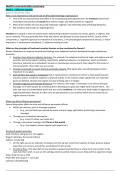Samenvatting
Health communication summary week 1-7 with articles
This summary consists of week 1-7 from the health communication course. They also contain a summary for every article that needed to be studied for the exam. My grade was a 7,9. Good luck!!
[Meer zien]




